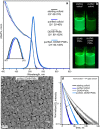Rationalizing and Controlling the Surface Structure and Electronic Passivation of Cesium Lead Halide Nanocrystals
- PMID: 30662955
- PMCID: PMC6333230
- DOI: 10.1021/acsenergylett.8b01669
Rationalizing and Controlling the Surface Structure and Electronic Passivation of Cesium Lead Halide Nanocrystals
Abstract
Colloidal lead halide perovskite nanocrystals (NCs) have recently emerged as versatile photonic sources. Their processing and luminescent properties are challenged by the lability of their surfaces, i.e., the interface of the NC core and the ligand shell. On the example of CsPbBr3 NCs, we model the nanocrystal surface structure and its effect on the emergence of trap states using density functional theory. We rationalize the typical observation of a degraded luminescence upon aging or the luminescence recovery upon postsynthesis surface treatments. The conclusions are corroborated by the elemental analysis. We then propose a strategy for healing the surface trap states and for improving the colloidal stability by the combined treatment with didodecyldimethylammonium bromide and lead bromide and validate this approach experimentally. This simple procedure results in robust colloids, which are highly pure and exhibit high photoluminescence quantum yields of up to 95-98%, retained even after three to four rounds of washing.
Conflict of interest statement
The authors declare no competing financial interest.
Figures




Similar articles
-
Luminescence and Stability Enhancement of Inorganic Perovskite Nanocrystals via Selective Surface Ligand Binding.ACS Nano. 2021 Nov 23;15(11):17998-18005. doi: 10.1021/acsnano.1c06480. Epub 2021 Nov 1. ACS Nano. 2021. PMID: 34723469
-
Surface Chemistry of Lead Halide Perovskite Colloidal Nanocrystals.Acc Chem Res. 2023 Jul 4;56(13):1815-1825. doi: 10.1021/acs.accounts.3c00174. Epub 2023 Jun 22. Acc Chem Res. 2023. PMID: 37347953 Free PMC article.
-
Surface Crystal Growth of Perovskite Nanocrystals via Postsynthetic Lead(II) Bromide Treatment to Increase the Colloidal Stability and Efficiency of Light-Emitting Devices.ACS Appl Mater Interfaces. 2020 Oct 7;12(40):45574-45581. doi: 10.1021/acsami.0c13212. Epub 2020 Sep 24. ACS Appl Mater Interfaces. 2020. PMID: 32914951
-
Defect Passivation in Lead-Halide Perovskite Nanocrystals and Thin Films: Toward Efficient LEDs and Solar Cells.Angew Chem Int Ed Engl. 2021 Sep 27;60(40):21636-21660. doi: 10.1002/anie.202102360. Epub 2021 May 28. Angew Chem Int Ed Engl. 2021. PMID: 33730428 Free PMC article. Review.
-
Recent Advances in Ligand Design and Engineering in Lead Halide Perovskite Nanocrystals.Adv Sci (Weinh). 2021 May 5;8(12):2100214. doi: 10.1002/advs.202100214. eCollection 2021 Jun. Adv Sci (Weinh). 2021. PMID: 34194945 Free PMC article. Review.
Cited by
-
Assembly-promoted repeatable enhancement of photoluminescence from cesium lead tribromide nanocubes under light illumination.Nanoscale Adv. 2024 Oct 15;6(22):5563-7. doi: 10.1039/d4na00665h. Online ahead of print. Nanoscale Adv. 2024. PMID: 39421588 Free PMC article.
-
Stabilized Perovskite Quantum Dot Solids via Nonpolar Solvent Dispersible Covalent Ligands.Adv Sci (Weinh). 2023 Aug;10(23):e2301793. doi: 10.1002/advs.202301793. Epub 2023 Jun 4. Adv Sci (Weinh). 2023. PMID: 37271856 Free PMC article.
-
Classical Force-Field Parameters for CsPbBr3 Perovskite Nanocrystals.J Phys Chem C Nanomater Interfaces. 2022 Jun 16;126(23):9898-9908. doi: 10.1021/acs.jpcc.2c00600. Epub 2022 Jun 1. J Phys Chem C Nanomater Interfaces. 2022. PMID: 35747512 Free PMC article.
-
All-Perovskite Multicomponent Nanocrystal Superlattices.ACS Nano. 2024 Mar 19;18(11):8423-8436. doi: 10.1021/acsnano.3c13062. Epub 2024 Mar 6. ACS Nano. 2024. PMID: 38446635 Free PMC article.
-
Robustness to High Temperatures of Al2O3-Coated CsPbBr3 Nanocrystal Thin Films with High-Photoluminescence Quantum Yield for Light Emission.ACS Appl Nano Mater. 2020 Aug 28;3(8):8167-8175. doi: 10.1021/acsanm.0c01525. Epub 2020 Jul 16. ACS Appl Nano Mater. 2020. PMID: 33817562 Free PMC article.
References
-
- Protesescu L.; Yakunin S.; Bodnarchuk M. I.; Krieg F.; Caputo R.; Hendon C. H.; Yang R. X.; Walsh A.; Kovalenko M. V. Nanocrystals of Cesium Lead Halide Perovskites (CsPbX3, X = Cl, Br, and I): Novel Optoelectronic Materials Showing Bright Emission with Wide Color Gamut. Nano Lett. 2015, 15 (6), 3692–3696. 10.1021/nl5048779. - DOI - PMC - PubMed
Grants and funding
LinkOut - more resources
Full Text Sources
Other Literature Sources
